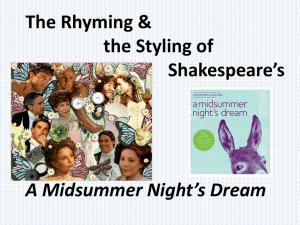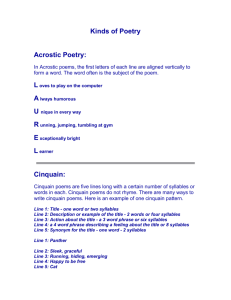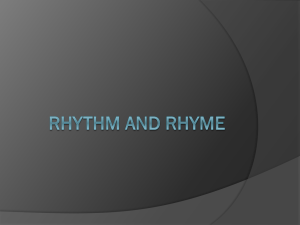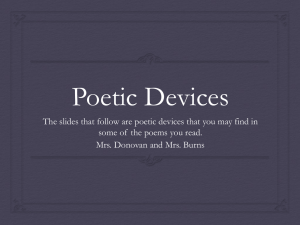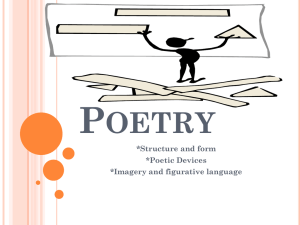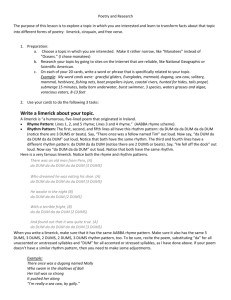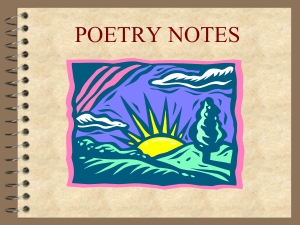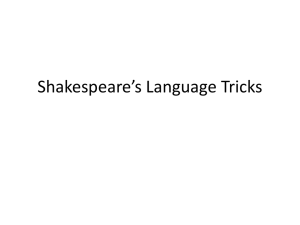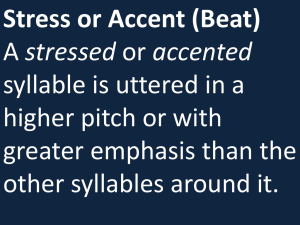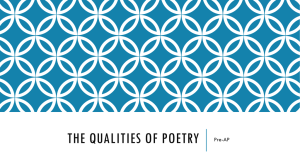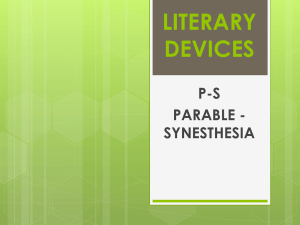File
advertisement
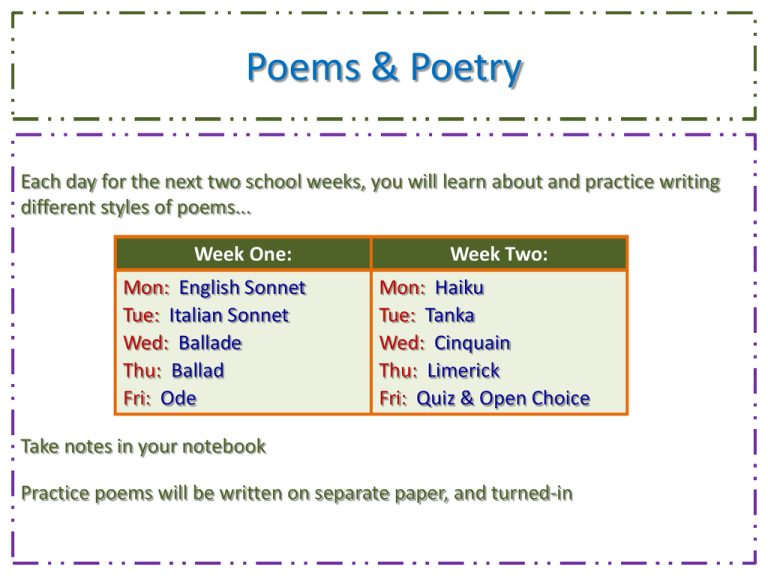
Poems & Poetry Each day for the next two school weeks, you will learn about and practice writing different styles of poems... Week One: Mon: English Sonnet Tue: Italian Sonnet Wed: Ballade Thu: Ballad Fri: Ode Week Two: Mon: Haiku Tue: Tanka Wed: Cinquain Thu: Limerick Fri: Quiz & Open Choice Take notes in your notebook Practice poems will be written on separate paper, and turned-in What is a Sonnet? A sonnet is a poem about an expressive thought or idea 14 lines, each line is 10 syllables long Its rhymes are arranged according to one of two schemes or styles: Italian or English... Italian = Two quatrains followed by six lines English = Three quatrains followed by a rhyming couplet The Structure of a Sonnet The “recipe” of a sonnet depends on the style used... English-style sonnet: A-B-A-B | C-D-C-D | E-F-E-F | G-G Italian-style sonnet: A-B-B-A | A-B-B-A | C-D-E-C-D-E The LETTERS indicate end rhyming words Example of an English-style Sonnet (A) (B) (A) (B) Scribbler! oh what a joy you can find here Eric is the one that heads the great team Full of poems, stories and happy cheer Hopefully it will make our readers gleam (C) (D) (C) (D) Bronte's Grammar is full of homework help Guest authors revealing secrets galore While the tricky puzzles will make you yelp There is no way Scribbler! will make you snore (E) (F) (E) (F) Eric will start a tale needing an end Fancy a challenge? Puzzle Time is here Shakespeare picks the great pictures you all send Ev'ry issue's jam-packed, let's give a cheer (G) How 'bout finding Eric hidden away (G) Jump on the Scribbler! wagon, come and play! Your Turn to Write a Sonnet Use the structure rules to write a sonnet about: Your favorite time of year (ex: holiday, birthday, vacation) Some things to consider or envision: - The season - Who or what your see, smell, hear - Where you are - What you do on the day(s) - Are you alone? If not, who are you with What is a Ballade? A ballade is a type of poem that first became popular in 14th century Europe In old times, a ballade was often taught and recited with music or rhythm to be learned more easily The Structure of a Ballade The “recipe” of a ballade includes three “ingredients” . . . Stanza Envoy Refrain Rhyme scheme for the stanzas is a-b-a-b Rhyme scheme for the envoy is b-c-b-C The capital letters in the rhyme schemes show where the refrain will be Example of a Ballade (a) (b) (a) (b) The bell sounds its last ring And others join in symphony. Down the street I’m running Twelve whole weeks in front of me. (b) (c) (b) (C) No more boring History, Or listening to what teachers say. This is the day that makes me happy Because I am on holiday! (Capital C = holiday; holiday is the refrain) (a) (b) (a) (b) I wonder what the summer will bring? Jumping in rivers and climbing a tree, When the sun is bright and shining. Staying indoors when outside it’s rainy. (b) (c) (b) (C) Playing on the Xbox or the Wii. Whatever the weather I’ll be okay. No more happy could I be Because I am on holiday! (Capital C = holiday; holiday is the refrain) Your Turn to Write a Ballade Use the structure rules to write a ballade about: Your favorite food or cuisine (style; Chinese, for example) Some things to consider before writing: - Who or what your see, smell, hear Where are you when you eat your favorite food/cuisine? How is it prepared or who prepares it? What are the ingredients? Are you alone when you eat it? If not, who are you with? Why do you enjoy it so much? What is a Ballad? A Ballad is a poem that tells a story Ballads are often used in songwriting because of their rhyme scheme A ballad is a poetic story, often a love story The Structure of a Ballad The ballad structure is as simple as matching end rhyme words in pairs (A-A-B-B) or triplets (A-A-A-B-B-B) Example of a Ballad (A) Late this morning, early last night (A) Two dead boys got up to fight. (B) Back-to-back each faced the other, (B) Drew their swords and shot each other. (C) A deaf policeman heard the noise (C) He came and shot alive the two dead boys (D) Don’t believe my story’s true? (D) Ask the blind man, he saw it too! Your Turn to Write a Ballad Use the structure rules to write a ballad about: Walking down the hallway at school Some things to consider or envision: - The time of day - Who or what your see, smell, hear - Where you came from (ex: your locker) - Where you are going - What you are thinking - Are you alone? If not, who are you with What is an Ode? An ode is a lyric poem An ode usually addresses a particular person or thing The style originated in Ancient Greece Structure of an Ode An ode does not have a rhyme scheme or syllable count An ode does have lines, and follow a single theme Odes use similes, metaphors, and sometimes hyperbole. Example of an Ode Oh Olive, You are as precious to me as any gem, With your beautiful, pure skin as smooth as silk And as green as the grass in summertime. I love your taste and the smell of your tender fruit Which hides beneath your green armor. Oh Olive, sweet, tasty Olive, How I love you so and my mealtimes wouldn't be the same If you weren't in my life. Oh Olive, Nothing can compare to you, nothing at all, You are food of the gods, a king's riches And, most importantly, you are mine, oh Olive! Your Turn to Write an Ode Use the structure rules to write an ode about: Your favorite celebrity / famous person Some themes or topics to consider: Dreams, Emotions, Family, Friendship, Hopes, Loss, Love, Memories, etc. In-class ode must have four quatrains After in-class ode is checked-off, write another ode about whatever topic you wish What are Cinquain, Haiku, & Tanka Poems? Cinquain, Haiku, and Tanka poems are short-verse works that usually don’t have a rhyme scheme (though they can) All three types of poems follow strict rules on syllable counts per line All three types of poems usually follow a single theme and express a thought or feeling about the theme Structures of Cinquain, Haiku, & Tanka Poems Cinquain syllable counts per line: Line 1 = Two syllables Line 2 = Four syllables Line 3 = Six syllables Line 4 = Eight syllables Line 5 = Two syllables Haiku syllable counts per line: Line 1 = Five syllables Line 2 = Seven syllables Line 3 = Five syllables Tanka syllable counts per line: Line 1 = Five syllables Line 2 = Seven syllables Line 3 = Five syllables Line 4 = Seven syllables Line 5 = Seven syllables Examples of Cinquain, Haiku, & Tanka Poems Cinquain (2-4-6-8-2) Haiku (5-7-5) Tanka (5-7-5-7-7) My mom Is so caring She is always helpful She is so beautiful and kind My mom The sky is so blue The sun is so warm up high I love the summer I love my kitten She is so little and cute She has a pink nose And lots of long whiskers too She purrs loud when I pet her Your Turn to Write a Cinquain, Haiku, & Tanka Use the structure rules to write a cinquain, a haiku, and a tanka Some themes or topics to consider: - Dreams Emotions Family Friendship Hopes Loss Love Memories What is a Limerick? Silly five-line poem that makes fun of something or teases; some are really quite mean-spirited and vulgar The style originated in 13th century England churches, but not wellknown until 18th century Limericks have set rhyme meter and scheme rules that must be followed Structure of a Limerick Rhyme scheme = A-A-B-B-A Rhyme meter: da DUM da da DUM da da DUM (A) da DUM da da DUM da da DUM (A) da DUM da da DUM (B) da DUM da da DUM (B) da DUM da da DUM da da DUM (A) Examples of a Limericks There was an old man from Peru (A = “ooh” sound) Who dreamed he was eating his shoe (A = “ooh” sound) He awoke in the night (B = “ite” sound) With a terrible fright (B = “ite” sound) To find that his dream was quite true (A= ooh sound) There once was a fellow named Tim (A = “im” sound) Whose dad never taught him to swim (A = “im” sound) He fell off a dock (B = “ock” sound) And sunk like a rock (B = “ock” sound) And that was the end of him (A = “im” sound) The limerick packs laughs anatomical (A = “ickle”) Into space that is quite economical (A = “ickle”) But the good ones I've seen (B = “een”) So seldom are clean (B = “een”) And the clean ones so seldom are comical (A = “ickle”) Your Turn to Write a Limerick Keep in mind the meter ... The poem should be said aloud in a sing-song meter Keep to one topic or theme throughout the poem Target is three in-class practice poems Keep rhyme scheme in mind ... The limerick must rhyme every line or every other line Topic or theme ideas: – Advice about life – A funny idea – A moral lesson – A silly story based on something that happened in your life Structure of an Acrostic A word or phrase is chosen to be written vertically down the side or middle of a paper “Cross” words are made using the letters of the “down” word(s) – The “proper” method is to use the letters of the “down” words as the first letters of “cross” words – If necessary, the “down” word letters can be end or middle letters of the “cross” words Acrostics DO NOT have to rhyme, but making them rhyme is a fun challenge; it is also challenging to try making a sentence (or even a paragraph) out of the acrostic Acrostics are written for a single theme or topic Example of an Acrostic Awesomely annoying Cross words Really fun and challenging Often used for study guides Simple to do Topic- or theme-related It doesn’t have to rhyme Consider making it rhyme for a challenge Your Turn to Write an Acrostic Try to use each “down” letter as the first letter of a “cross” word You can use “down” letters for middle or end letter of “cross” words Try to either make it rhyme, or to make it one single sentence Incorporate elements of the topic or theme into the acrostic Topic: – Your first name, middle initial, and last name Your Turn to Write an Acrostic Creative Hefty Authoritative Daffy Annoying Manatee-like Land-Walrus Obese Person Excessive Successful
